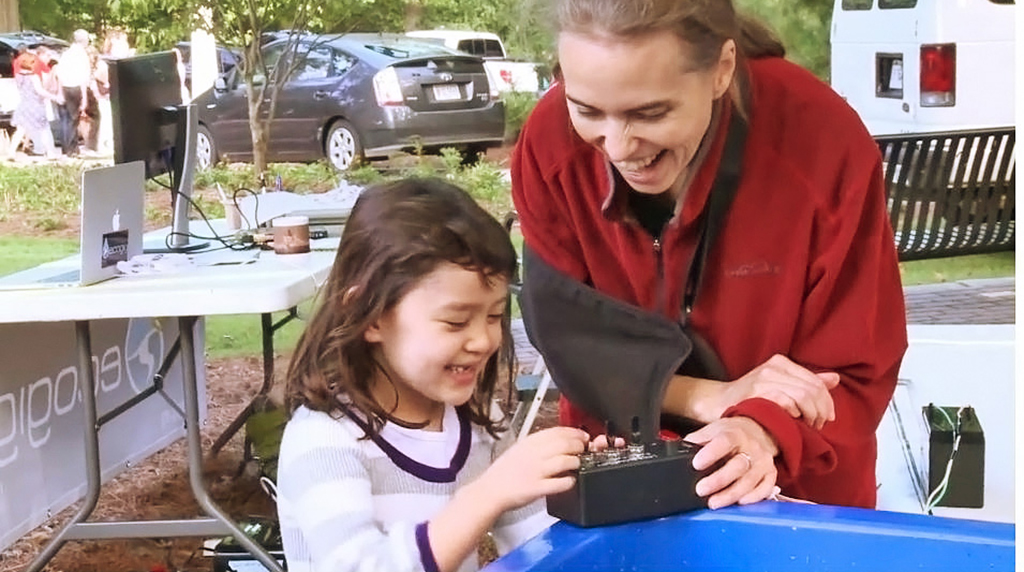October 21, 2014
What gets kids of all ages more excited than a day of hard-hitting SEC football? Robots!
Scientists with the Ecosystem Impacts of Oil & Gas Inputs to the Gulf (ECOGIG) consortium recently launched the “Science at the Stadium” education program to connect fascinating undersea research technology with the thrilling college football atmosphere.
On game day at the University of Georgia (UGA) and University of Mississippi (UM) stadiums, researchers invited kids to pilot remotely operated vehicles (ROVs), the robotic submarines used in marine research.

(Click to enlarge) Ph.D. student Ryan Sibert directs the young ROV pilots at a game in Athens, GA. (Photo credit: Christine Laporte)
Standing with the 400-gallon water tanks housing the ROVs, they explained to football fans how this technology helps them learn about deep ocean ecosystems. Fans could also watch underwater footage from recent ECOGIG ROV missions to document Gulf conditions since the Deepwater Horizon oil spill.
UGA biogeochemist and microbial ecologist Samantha Joye, an ECOGIG lead scientist, initiated the program earlier in the season, saying “Athletic venues draw a diverse and large crowd and present a fantastic place to share our knowledge and enthusiasm with young people of all ages and their parents. It’s a great way to get people excited about science and to educate them about the ocean and environmental conservation and sustainability at the same time.”

(Click to enlarge) Science enthusiasts Yaniv Goulet (left) and Gilad Goulet (middle) operate an ROV they made at the University of Mississippi’s game against Alabama while their father, Dr. Denis Goulet, looks on. (Photo credit: Michelle Edwards)
Children who complete all the on-site “training” activities at the UGA events are awarded a laminated “ROV Pilot in Training License” attached to a Georgia Bulldog lanyard.
UM geological engineer and ECOGIG director Geoff Wheat explained the importance of connecting kids to science and engineering: “These are two fields that need more graduates. Our approach is to get the kids involved in real-world experiences. They really light up with hands-on problem-solving activities.”
Visitors have the opportunity to build their own ROV and see the Mola Mola, an Autonomous Underwater Vehicle (AUV) that takes detailed pictures of the seafloor. These game-day activities complement UM’s ongoing 4thgrade outreach program. “It opens doors to various school systems,” said Wheat, explaining that they go into schools and talk about the oil spill and how ROVs and AUVs can be used to study coral and to assess ecosystem health.

(Click to enlarge) The University of Mississippi offered young scientists an opportunity to make their own ROVs before the game. (Photo credit: Michelle Edwards)
The venue is proving to be an effective means for reaching new audiences. “The event was a HUGE success,” Joye happily reported about last week’s program at the UGA game. “We had over 200 kids and many adults of all ages. It was so busy that we lost count and ran out of ROV drivers’ licenses and lanyards. Many adults came by to talk about the Gulf, deepwater drilling, you name it. It was really great fun!”
Michelle Edwards, an ECOGIG outreach team member, reports similar success in Oxford, citing their visible location at the UM Lyceum, promotion in the football program Rebel Gameday, and Ole Miss tailgating as big pluses.
“It’s very family-friendly, so there are lots of kids,” says Edwards. “We have been averaging 100 or more per game at our tents, and they love the whole process of constructing and driving the ROVs. Kids of all ages, even college students, check us out. We get lots of questions and positive comments from kids and parents. It’s a great experience!”
Science at the Stadium taps into people’s curiosity by offering a fun experience and learning activity that involves undersea research and exploration. Christine Laporte, an ECOGIG outreach team member, sums up their ultimate goal, “It’s all about sparking the next generation’s imagination about science and conservation, engineering, and adventure.”
ECOGIG has held several Science at the Stadium events during this year’s football season. They are planning more at other colleges and hoping, as Joye expressed, that the “idea spreads like wildfire through the GoMRI network and elsewhere.”
************
The original article may be found here.
This research is made possible by a grant from BP/The Gulf of Mexico Research Initiative (GoMRI) through the Ecosystem Impacts of Oil and Gas Inputs to the Gulf (ECOGIG) consortium. The GoMRI is a 10-year independent research program established to study the effect, and the potential associated impact, of hydrocarbon releases on the environment and public health, as well as to develop improved spill mitigation, oil detection, characterization and remediation technologies. An independent and academic 20-member Research Board makes the funding and research direction decisions to ensure the intellectual quality, effectiveness and academic independence of the GoMRI research. All research data, findings and publications will be made publicly available. The program was established through a $500 million financial commitment from BP. For more information, visit http://gulfresearchinitiative.org/.


















 back to top
back to top